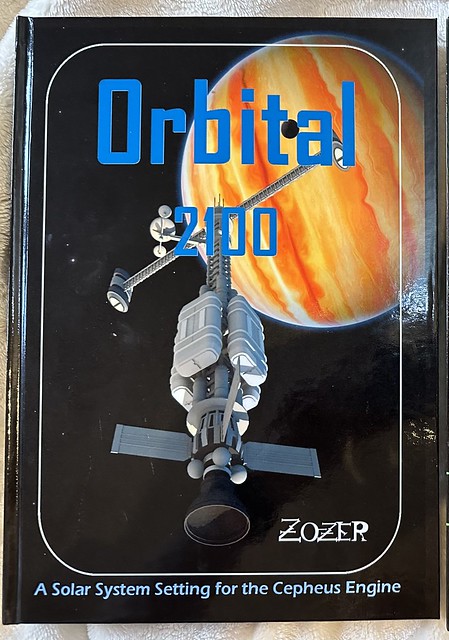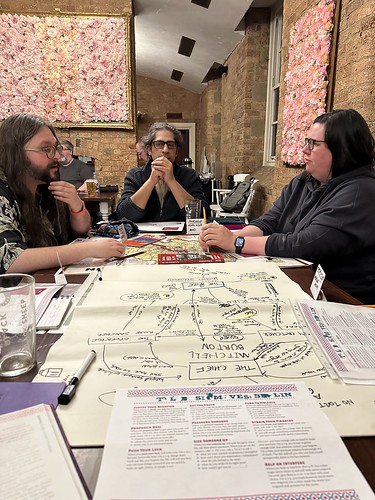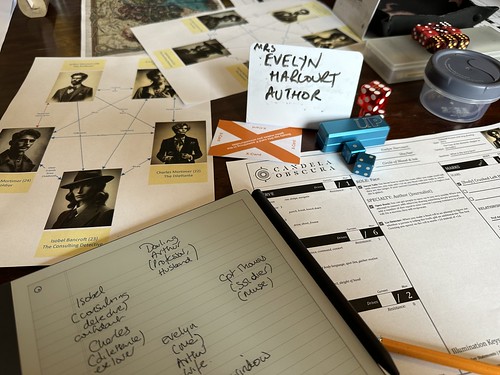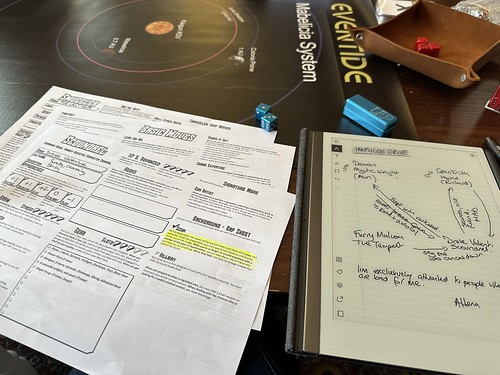 |
| Orbital 2100 - a setting usable with Traveller or Cepheus |
Orbital 2100 is Zozer Games’ prequel to the popular Hostile setting. It uses the Cepheus Engine but should be easily usable with Mongoose Traveller (although you’ll need to tweak some space combat elements if you’re using either the 2nd edition or 2nd edition refresh). It is set in our solar system in 2100, one hundred and twenty-five years before the main Hostile settings. It is pre-FTL (faster-than-light) and the ships and vessels used to travel between planets are recognisable extension on what is possible today.
It is a 240-page colour hardcover print-on-demand book, ordered via Lulu. The copy that I have is the second edition, published in 2016. If you get the hard copy and reach out to Zozer, they will (very quickly) send you the PDFs on DriveThruRPG. The book is mainly black and white, with some effective images included. However, I really don't like the layout, which continues Zozer’s ‘use a bigger font-size than you need’ theme. As the font used looks like Tahoma with italics used liberally in a single column format, it looks like an essay or report in parts, especially as the page numbering is always on the same side whether on a left or right handed page. It's clear enough to read though. I don’t like their layout, but it doesn’t make my eyes bleed nor have quite the same visceral reaction as the ‘Made on Timeworks Publisher in the 1990s’ approach that rendered Sorcerors of Ur Turuk unreadable to me. There are a small number of typos scattered through the text. Overall, a functional book, rather than a pretty one.
The book is structured into twelve chapters, beginning with an overview of the situation in the game setting and a variety of suggestions on how you could use the book; for example, as a set of mechanics to play in the past of another setting that uses more traditional SF-tropes.
The second chapter dives into the ongoing Cold War between the Earth Union and Luna. The setting predates the Expanse TV series, but there are echoes between the two. It also reminds me of Paul McAuley's
'Quiet War' novel series, which has a similar conflict over the resources of the solar system. There's a feeling of tension in the writing, and the two protagonists have just stepped back from the brink. An uneasy peace exists; Luna has the power to drop mass-driver rocks on Earth (and has, in the past) and Earth has enough space-based nuclear weapons to destroy the settlements on the Moon. This could be a backdrop to your game, or you could put the players right at the heart of it. The setting is Tech Level 9 with Tech Level 11 Computing & Electronics.
The third chapter looks at the various organisations in 2100. It starts with government agencies of the type that the players are likely to encounter (research, police, military) before moving into corporations. The corporations have some easter-eggs in them if you've already explored the Hostile line, as they are the precursors to those that dominate the future, 125 years later. A number of NGOs and criminal organisations are also described before the chapter rounds out a short piece of fiction to set the mood, sadly marred by the use of a large block of italics for the text.
Chapter four talks about how to alter the Cepheus mechanics for the setting when creating characters. The main changes are that social standing is no longer linked to aristocratic titles, but a combination of fame and wealth, and the background skill selection is more tailored. Careers in 2100 are mapped against the careers in the core book, and there are tweaks to some of the skills and how they cascade. Military and spacer ranks are also adjusted to fit the setting background, along with some changes to the mustering out process to reflect that characters are more likely to still be in employment within their career than having retired from it. Finally, the chapter presents Nikolay Kamov, a plain clothes agent of the Space Activities Regulatory Agency. The character is reassuringly summarised with a short UPP code and skills list that will be familiar to anyone who has played Traveller in the past.
The fifth chapter gets technical, exploring spacecraft design. Orbital lacks jump-drives or other FTL, and also does not have artificial gravity. Starships use thrust or spin to create gravity; the technology is more akin to 2001: A Space Odyssey, 2010, or the Expanse than the classic Third Imperium setting. Ships use chemical reaction based rockets or nuclear-thermal rocket engines for propulsion. The latter are the main drives for ships, and an extrapolation of work explored in the mid-20th Century. A nuclear fission reactor is used to superheat liquid hydrogen as reaction mass. Ships will usually boost to the required velocity, and then burn to slow down and rendezvous with their destination after coasting for much of the journey, with the same kind of orbital mechanics that probes sent out by NASA and the ESA use today.
Radiation has significant effects, and drives need shielding. Deep Space Vessels also carry flare dampers that create an artificial magnetosphere to protect the crew and vessel from radiation from Saturn and Jupiter, and usually also have storm shelters which are protected. Low berths are used for long haul flights, and are slightly more survivable than usual.
The design sequence approach will be familiar to anyone who has used Traveller before; you select a hull size and fill it with components. All hulls are distributed, very much lattice-works of components not designed to enter an atmosphere. Weapon systems can be fitted with a combination of railguns, particle beams, missiles and lasers. Autonomous Kill Vehicles have station and ship killing capabilities. They're large weapons likely to cause a huge amount of damage, available in kinetic kill, nuclear, bomb-pumped X-ray laser and ground strike variants.
Engineering defines function, and most DSVs will have a similar design with the reactor and NTR drive at the rear with fuel clustered nearby. The crew and passengers will be located as far away from the drives as possible, with radiation shielding between.
There is an alternative nuclear pulse fusion drive detailed in the book, a TL10 system similar to that seen in the Expanse. This drive removes the need to burn and coast, which means overall a much faster transit time (eight days to Jupiter from Earth rather than eight months). The constant thrust will mean a different style of ship, more skyscraper like rather than International Space Station style.
The design sequence then moves onto orbital vehicles, which may be designed to enter an atmosphere. These are the small craft of the setting. Technology includes chemical reaction rockets, fuel cells and solar panels. Flare dampers may be included to protect crew, but the power demands of these system means that their duration of their protection is too short to be effective in Jovian and Saturn space. In those areas, small DSVs fill the orbital ferry role. The section concludes with guidance on how to modify the orbital vehicle design sequence to make a launch vehicle. It's interesting that when the book was written, SpaceX had yet to successfully carry out a controlled Falcon-9 booster landing, but there are rules to design rockets with that feature.
The sixth chapter explores operating spacecraft, and has a simple system to account for the movement of the planets in the inner system. This uses a template to track movement through the various orbits. Outer system travel ignores this on the basis that the outer planets will tend to be broadly in the same place in any ten year time frame. There's discussion of LaGrange points, Gas Giant Moons and how fuel impacts operations. Fuel is a limiting factor, with even DSVs needing husband supplies; two thirds of their typical fuel tankage will be used for the burn to leave orbit and enter orbit at the destination planet. Simple mechanics are presented for maintenance and revenue during starship operations. There's an encounter table, which varies based on which part of the solar system you're in. This is followed by guidance on how to run space combat in this kind of environment. This isn't stand alone, but does modify the sequences in the core rules.
The next chapter is entitled 'Hardware' and is the equipment list. There's a significant section on space suit designs, which makes sense as they are much more critical in this kind of lower technology setting compared to Traveller's Third Imperium. Rovers, computers, orbital vehicles, launch vehicles and deep space vehicles all get a variety of examples, more than enough to run most of what you need for a campaign. The space station section gives examples of multiple 10-ton modules that can be used to quickly construct a space-station.
Chapter 8 covers Orbital Society, starting with law enforcement, but moving on to art and culture (including the Eros Wrap, a massive lighting installation around the asteroid), and then a discussion of the kinds of towns, outposts and bases you may encounter. Most of these will rely on oxygen and fuel refineries if installed planet-side. Regolith-bags or burying modules provides protection from solar flares. On Europa, the installations are underwater, below the ice-crust. There are examples of orbital module stations (and how to recover older, abandoned ones) and also larger space colonies such the three O'Neill stations in Earth space in the L4 and L5 Lagrange points. The section also covers typical DSV operations and treaties and regulations agreed between Luna and Earth, before concluding with a short description of the 'Earth Orbit Network' of launch facilities and low and high orbit stations.
The ninth chapter makes it real by exploring the challenges of working in Zero-G before looking at ways to die is space. This starts with 'blow-outs' (pressure loss) and explores how to puncture the hull (and the speed of decompression following) and the effect of vacuum on the human body (you'll stay conscious for 12 seconds or so). Alternatives to guns are suggested. Other exciting ways to die include exposure to extremes of temperature (get cooked on Mercury and Venus, or frozen on Mars or Titan), or poison gases in the atmosphere of Venus or Titan. Finally, radiation is the pervasive killer. If a ship loses its flare damper, or you're caught outside in a solar storm or just in Jovian space, then you are likely to become very sick. Airlocks are described in some detail. The chapter has sections on asteroid mining and establishing an outpost to wrap things up.
The tenth chapter looks at the worlds in the Sol system. They're all presented with their Traveller style UWPs (Planetary Profiles), then the significant ones all have entries with an image, more detail on the world, its planetology, human development and places of interest. There's enough painted in broad brushstrokes to give hooks for the referee to dig into when running the game.
The penultimate chapter discusses running Orbital. It gives ideas of the kind of activities characters could get involved in and guidance on how to build a campaign. This is important; I can remember reading Transhuman Space, really liking it but struggling to work out how to run it. The author recommends giving the players secret agendas; links to the organisations in the setting that may create friction or slightly different needs on the mission that they are undertaking. Imagine the slightly different motivations you see in the characters in the Expanse. There's an example mission to show this (which looks like a fun session with enough friction to create some interesting interactions). The section rounds out with example NPCs and then a discussion on Aliens and are they out there (answer = 'yes'). Ruins have been found on Mars and there are other intriguing hints, some of which are explored further in Hostile.
The final chapter lists recommended movies, TV series, books, roleplaying games and web-links to look at for inspiration. An Appendix N for the setting. There's some really good recommendations there.
The book rounds out with the Cepheus Engine Compatibility Statement, Mongoose Traveller OGL and the NASA/JPL declaration.
I really like this setting. It feels fresh and different to many other SF-games and it feels real. Space is a frontier and dangerous and humanity is confined to a single solar-system and is in a period of Cold War. Corporations are gaining influence and there's an opportunity to make difference.
I've rated it four stars out of five (content 5 star, layout 3 star).
Highly recommended.
4 February 2024







